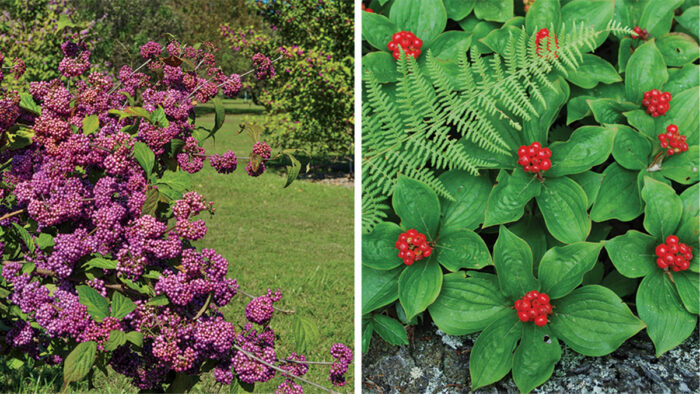
Flowers are usually the first things that grab our attention when we are selecting plants to add to our landscapes. However, most plants only flower for a short period of time, so it behooves us to consider plants’ other attributes—and there are many! Sometimes the same flowers that seduced us into opening our wallets are replaced with an amazing fruit display. Colorful fruits of all shapes and sizes can add drama to our landscapes throughout the year. In addition to their visual beauty, many fruits are important sources of nutrition for wildlife, particularly birds. Here are a few examples of awesome plants whose fruit shines in the garden in summer, fall, and winter.
Learn more about gardening for the birds
How to help birds survive winter
Gardening for birds and pollinators
Plants for Birds for Your Region
Shrubs
‘Heavy Berry’ beautyberry has branches dripping with tight purple clusters
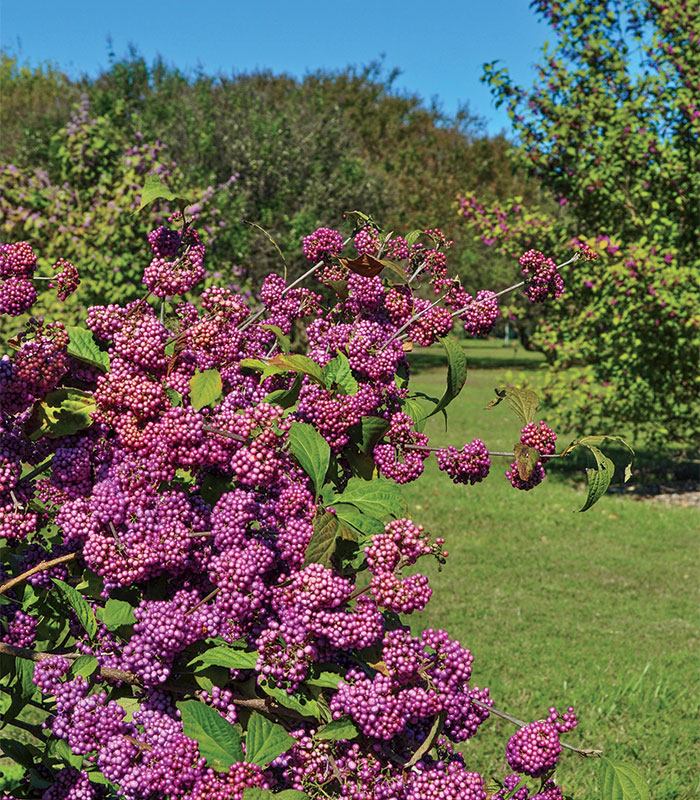
Name: Callicarpa japonica ‘Heavy Berry’
Zones: 5–8
Size: 4 to 6 feet tall and wide
Conditions: Full sun to partial shade; average, well-drained soil
Native range: China, Taiwan, Japan, Korea
Throughout spring and summer, beautyberries receive little attention. Jump ahead to late summer and fall, and all eyes gravitate to the stunning fruit display this genus is known for. ‘Heavy Berry’ in particular screams for attention, producing dazzling clusters of BB-size, shiny, violet-purple fruits up and down upright stems. The fruits persist for a couple of months, or until they fill the bellies of hungry birds. Prior to this magical display, hundreds of tiny pinkish-white flowers open in late spring and would normally go unnoticed, hidden among the foliage, if not for a surprisingly sweet fragrance that urges closer inspection. Pruning beautyberry to 10 inches from the ground every couple of years in late winter will result in strong, vigorous plants, and because flowers form on new growth, fruit production will not be affected.
Black chokeberry is a favorite of many different birds
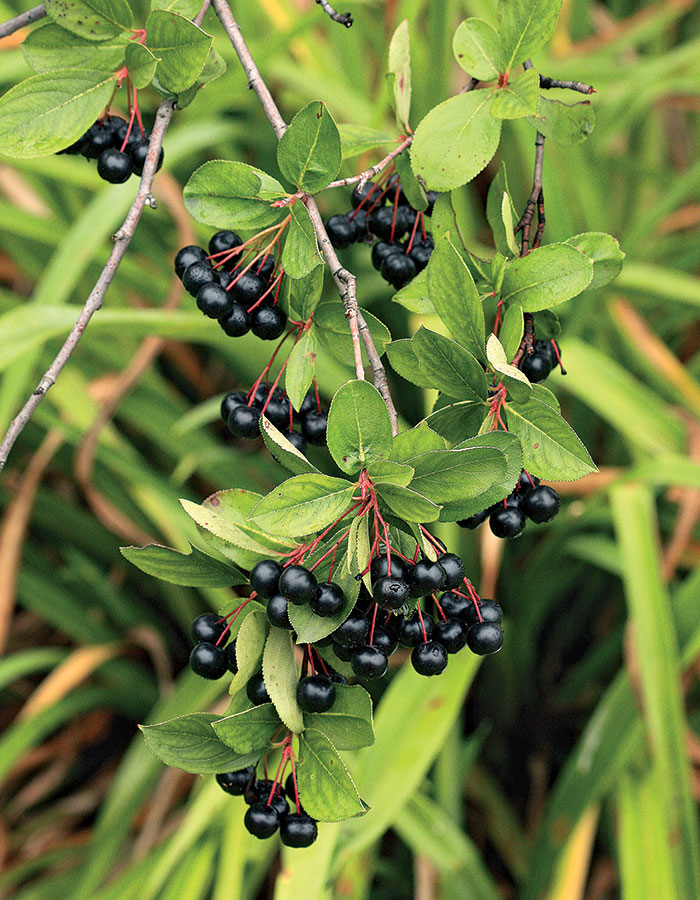
Name: Aronia melanocarpa
Zones: 3–8
Size: 3 to 8 feet tall and 3 to 6 feet wide
Conditions: Full sun to partial shade; average, well-drained soil
Native range: Eastern North America
In recent years, black chokeberry has risen in popularity as a superfruit. Health benefits aside, this native shrub is a great alternative to burning bush (Euonymus alatus,* Zones 4–8) because of its consistently brilliant scarlet fall color. But in midspring, clusters of five-petaled white flowers, each decorated with showy pink stamens, sit atop upright stems. The subsequent fruits are quite astringent at first and need some time to mature before you grab a handful. Birds also take advantage of the fruits’ nutritional qualities. I have witnessed black chokeberry covered with flocks of hungry robins and eastern bluebirds. Both your garden and the local wildlife will reap the benefits of including this fantastic suckering shrub in your yard.
Gorgeous white fringetree flowers give way to large blue orbs
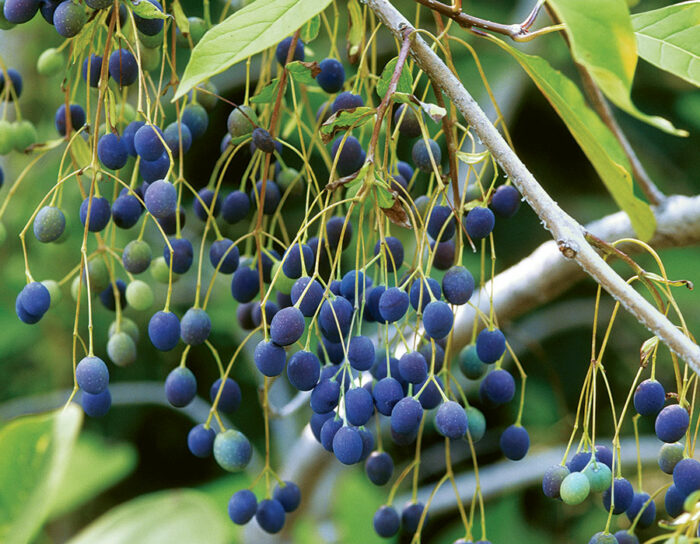
Name: Chionanthus virginicus
Zones: 3–9
Size: 10 to 20 feet tall and wide
Conditions: Full sun to partial shade; average, well-drained soil
Native range: Southeastern United States
Despite having southern roots, white fringetree is a fantastic large shrub or small tree for northern gardens. In early summer, branches are decorated with 4- to 8-inch-long pendulous clusters of fringelike, creamy-white flowers that emit a subtle, sweet fragrance. White fringetree is typically dioecious (meaning there are male and female plants), and the flowers on the boys tend to be showier than those on the girls. Female plants make up for their less impressive floral display by producing luscious bunches of fruit that resemble blue black olives. These are enjoyed by an assortment of wildlife. In addition to its cold-hardiness, this beneficial native requires little maintenance, has few (if any) insect and disease problems, and has proven to be tolerant of urban conditions.
Bright pink and orange are a sight to behold on strawberry bush
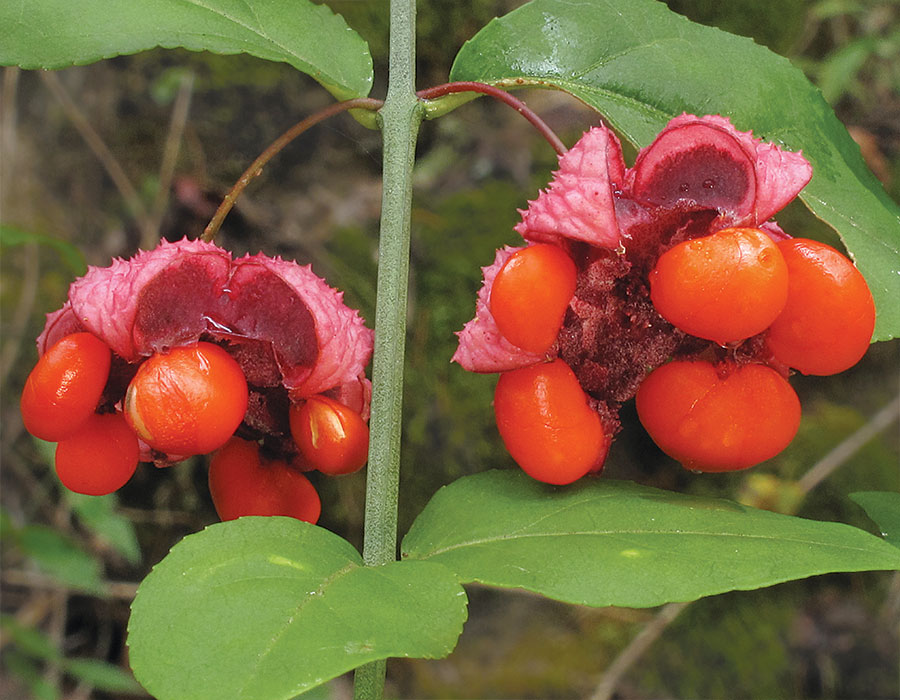
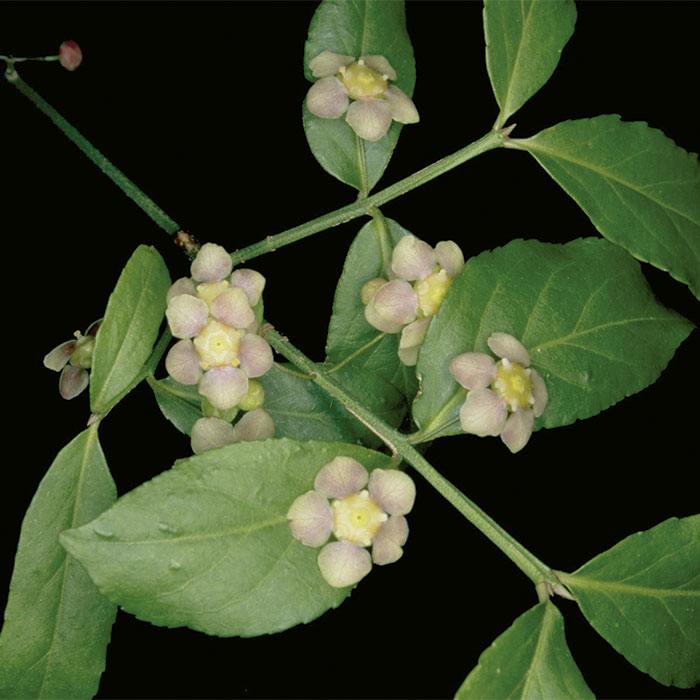
Name: Euonymus americanus
Zones: 6–9
Size: 4 to 6 feet tall and wide
Conditions: Partial shade; moist, well-drained soil
Native range: Eastern United States
Strawberry bush inhabits the understory of moist woodlands in its native habitat, forming sprawling colonies of green to purplish-green stems. The flowers that bloom in late spring are not particularly showy, but after the pollinators visit, the resultant fruit display is noteworthy. Verrucose seed capsules mature into an eye-catching vibrant pink and eventually split open to reveal bright orange seeds, leading to the common name of “hearts-a-burstin’,” which in my opinion is a better description of this plant than “strawberry bush.” Witnessing this fruit spectacle will certainly amaze you. The contrast of pink seed capsules and orange seeds is unlike much else you might see in the garden.
Trees
Alien-looking fruits turn heads toward Ashe’s magnolia

Name: Magnolia macrophylla subsp. ashei
Zones: 5b–9
Size: 15 to 30 feet tall and wide
Conditions: Full sun to partial shade; moist, acidic, well-drained soil
Native range: Florida panhandle
Want to add a tropical look to your garden without having to remove a mushy lump from the ground after the first hard frost? Consider adding this exotic-looking understory tree. Its exceptionally large leaves, reaching up to 30 inches long and 10 inches wide, provide a big, bold texture in the landscape. In addition, unlike most magnolias whose flowers shine in early spring, the blooms of Ashe’s magnolia open in late spring or early summer, avoiding any late frosts. The flowers, which are the size of dinner plates, are white with small amounts of violet in their centers. They emit an intoxicating fragrance. These blossoms are replaced with impressive 3-inch-long, rosy-pink fruits consisting of multiple carpels (seed-bearing structures) that, when mature, split open to reveal vibrant orange seeds. So grab your lawn chair and piña colada, and sit under the cooling shade of this southern belle.
American wintergreen makes a fragrant creeping ground cover
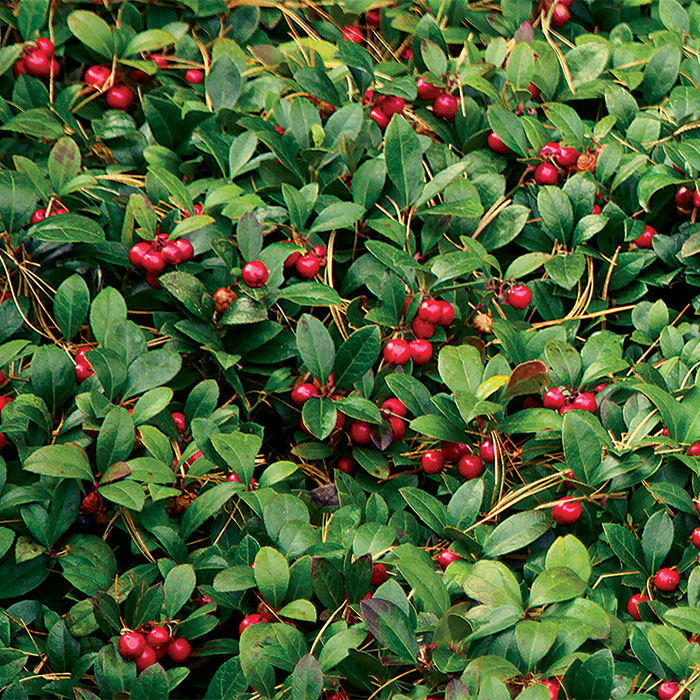
Name: Gaultheria procumbens
Zones: 3–8
Size: 3 to 6 inches tall and 6 to 12 inches wide
Conditions: Partial to full shade; moist, acidic, well-drained soil
Native range: Eastern North America
Ground covers provide many benefits to our landscapes, such as reducing soil erosion and suppressing weeds. Selecting evergreen ground covers creates additional year-round appeal. One of the best short evergreen creepers is American wintergreen. It has exceptional glossy, dark green leaves that shine throughout the year, often taking on maroon tones in winter, more so when exposed to more sun. Being in the heath family, it has small, bell-shaped flowers that bloom in summer and resemble those of its close relatives, such as species of blueberries (Vaccinium spp. and cvs., Zones 4–9). Showy red fruit, a good winter food source for many species of birds, replaces the flowers and wonderfully complements the lustrous foliage. Crush a leaf or try a berry to enjoy the fresh wintergreen fragrance and flavor.
The dangling berries of longstalk holly set it apart
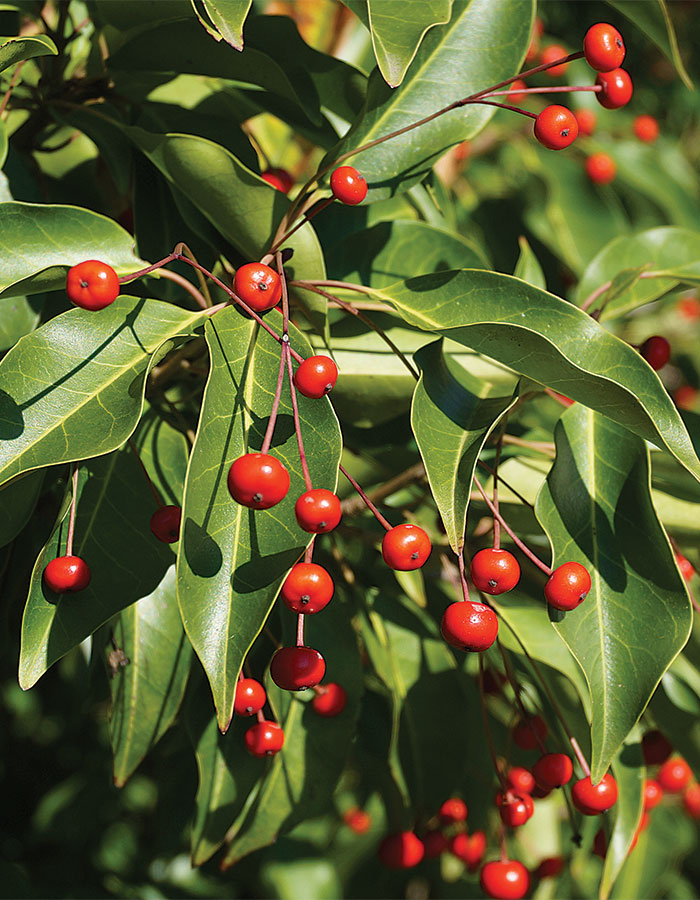
Name: Ilex pedunculosa
Zones: 5–8
Size: 15 to 30 feet tall and 15 to 20 feet wide
Conditions: Full sun to partial shade; average, well-drained soil
Native range: Japan, China, Taiwan
Considered one of the hardiest Ilex species, longstalk holly distinguishes itself from others in the genus with its smooth-margined leaves and red autumn berries held on long, graceful, pendulous stalks. This fruit persists into winter. Most hollies are dioecious, with fruit developing on the female plants. Both sexes, however, are needed to ensure a beautiful fruit display. I have had great success growing this holly, which can develop as a small tree or large shrub, under a high canopy with dappled shade. As with most broad-leaved evergreens, avoid planting longstalk holly in exposed sites where it can experience damage from harsh winds and sun, particularly in the winter.
Perennials
Gaze at white baneberry to see it looking back at you
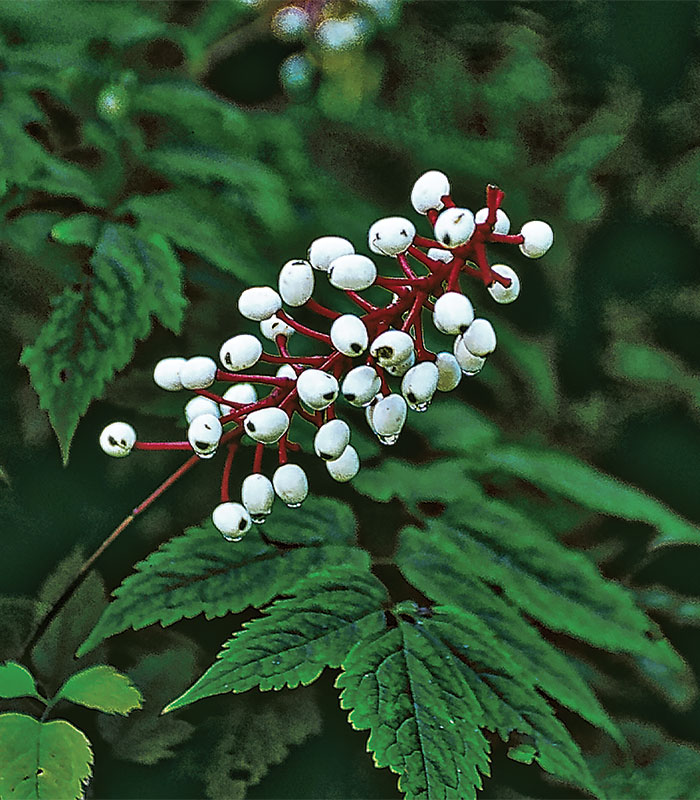
Name: Actaea pachypoda
Zones: 3–8
Size: 1½ to 2½ feet tall 2 to 3 feet wide
Conditions: Partial to full shade; moist, rich, well-drained soil
Native range: Eastern North America
I have always been intrigued by how our native plants got their common names. Often a plant’s common name refers to a particular physical characteristic. A great example of this is the alternative common name for white baneberry: doll’s-eyes. In late summer, clusters of brilliant white, pea-size fruits develop, each with a black spot resembling the porcelain eyes used in doll making. Even better,
these “eyes” are held on contrasting vivid pinkish-red stalks and look appetizing—but refrain from the temptation, as they are very poisonous. The fruit glistens in the lower light of the shade garden, drawing attention from afar. Earlier in spring, bottlebrush-like clusters of tiny white star-shaped flowers open above attractive clumps of compound foliage, to the delight of pollinators. Regardless of how you refer to it, white baneberry deserves a special spot in a woodland garden.
The red fruit of bunchberry jumps out in the middle of summer
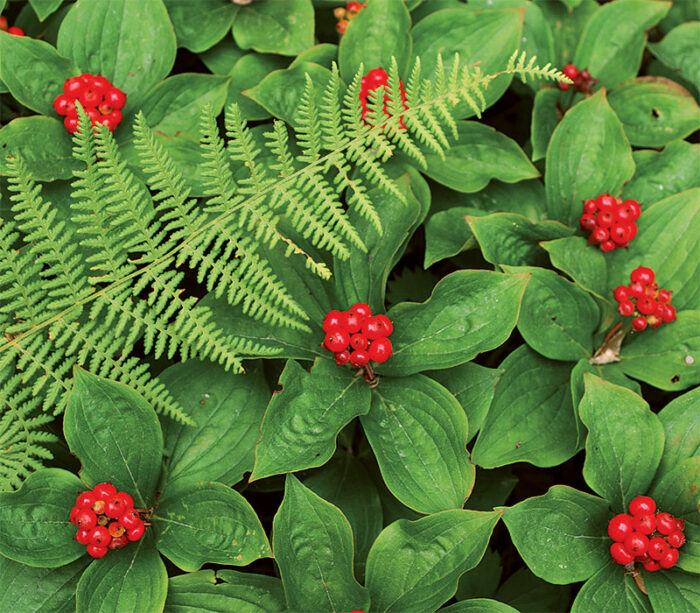
Name: Cornus canadensis
Zones: 2–6
Size: 4 to 9 inches tall and 12 inches wide
Conditions: Partial shade; rich, acidic, well-drained soil
Native range: Northern North America, Greenland, eastern Asia
I tried multiple times to grow this wonderful ground cover in my south-central Connecticut garden, but to no avail. Now that I live in Maine, I find this diminutive dogwood throughout the neighboring woodlands. It seems to prefer cooler, less humid northern climates. In late spring, the forest floor sparkles with clusters of tiny, greenish-yellow flowers subtended by four showy white bracts that attract several species of native bees. Raspberry-red fruit clusters develop in the heat of the summer and persist through fall or until they are eaten by hungry birds or mammals. Autumn’s cooler temperatures encourage the leaves to transition to a wine-red color, continuing bunchberry’s seasonal interest.
Why is my plant not producing fruit?
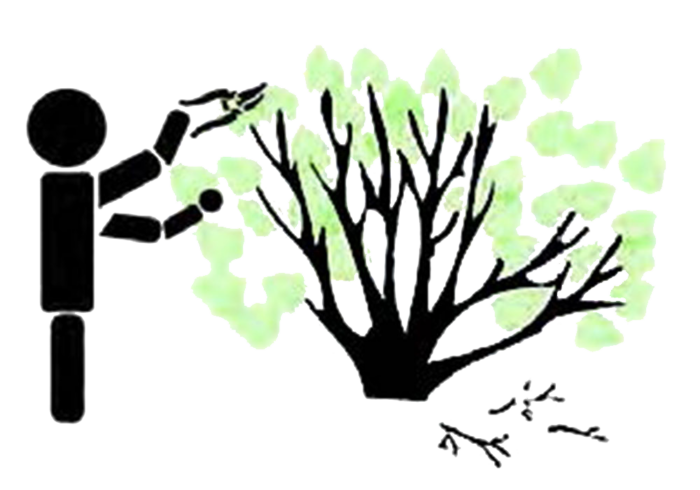
Picture this: You have picked out a plant for its stunning berry display, but disappointment quickly ensues because the anticipated display doesn’t happen. Why? There are several possibilities.
1. If you are an overly aggressive pruner, or are not pruning correctly, your manicured plant will likely not give you the anticipated fruit display. Research how to prune your specific plant and if it needs pruning at all.
2. The age of a plant can also be a culprit; your plant may not have reached the level of maturity required for it to consistently flower and fruit.
3. The light level may be too low. Research the proper lighting situation for your plant. Increasing the amount of sunlight when appropriate often results in more flowers and, subsequently, more fruit.
4. Too much fertilizer encourages lots of vegetative growth. The plant may focus more on producing new stems and leaves than producing flowers, and fruit production can suffer because of this.
5. Often, such as in the case of most hollies, the reason for poor berry production is that the plant is dioecious, with male and female flowers produced on separate plants, and you only have a female. No male pollinator nearby results in no fruit on the female. Many nurseries are now listing the suggested male plants on the labels of females, so be sure to check them.
*Invasive Alert:
Burning bush (Euonymus alatus)
This plant is considered invasive in CT, DE, GA, IN, KY, MA, MD, ME, MN, NH, NJ, NY, PA, RI, SC, TN, VA, WI, and WV.
Please visit invasiveplantatlas.org for more information.
Andy Brand is the director of horticulture at Coastal Maine Botanical Gardens in Boothbay.



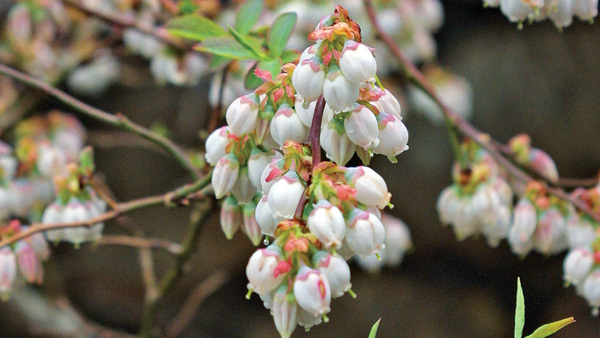













Comments
Log in or create an account to post a comment.
Sign up Log in